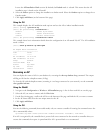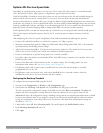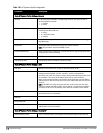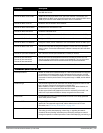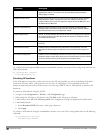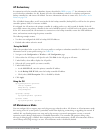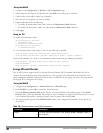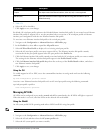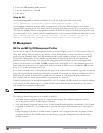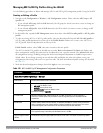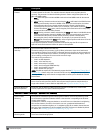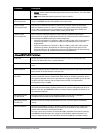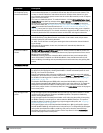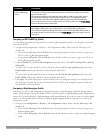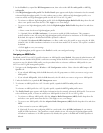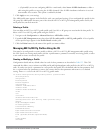
424 | AccessPoints(APs) DellPowerConnectW-SeriesArubaOS6.2 | User Guide
4. Locate the LED operating mode parameter.
5. From the drop-down list, select off.
6. Click Apply.
Using the CLI
Use the ap system-profile command to disable LEDs for all APs using a particular system profile.
(host) (config)# ap system-profile <profile-name> led-mode {normal | off}
Use the ap-leds command to make the LEDs on a defined set of APs either blink or display in the currently
configured LED operating mode. Note that if the LED operating mode defined in the AP’s system profile is set to
“off”, then the normal parameter in the ap-leds command will disable the LEDs. If the LED operating mode in the
AP system profile is set to “normal” then the normal parameter in this command will allow the LEDs light as usual.
(host) (config)# ap-leds {all | ap-group <ap-group> | ap-name <ap-name> | ip-addr <ip
address> | wired-mac <mac address>} {global blink|normal}|{local blink|normal}
RF Management
802.11a and 802.11g RF Management Profiles
The two 802.11a and 802.11g RF management profiles for an AP configure its 802.11a (5 Ghz) and 802.11b/g (2.4
GHz) radio settings. You can either use the “default” version of each profile, or create a new 802.11a or 802.11g
profile using the procedures below. Each RF management radio profile includes a reference to an Adaptive Radio
Management (ARM) profile. If you would like the ARM feature to dynamically select the best channel and
transmission power for the radio, verify that the RF management profile references an active and enabled ARM
profile. It can be useful to set the Max Tx EIRP parameter in the ARM profile to 127 (the maximum power level
permissible) until it determines the signal-to-noise radio on the links. If ARM is active, the Max Tx EIRP can also
be set to 127 to allow maximum power levels.
If you want to manually select a channel for each AP group, create separate 802.11a and 802.11g profiles for each AP
group and assign a different transmission channel for each profile. For example, one AP group could have an 802.11a
profile that uses channel 36 and an 802.11g profile that uses channel 11, and another AP group could have an
802.11a profile that uses channel 40 and an 802.11g profile that uses channel 9.
With the implementation of the high-throughput IEEE 802.11n standard, 40 MHz channels were added in addition
to the existing 20 MHz channel options. Available 20 MHz and 40 MHz channels are dependent on the country
code entered in the regulatory domain profile.
NOTE: Changing the country code causes the valid channel lists to be reset to the defaults for the country.
The following channel configurations are available in ArubaOS:
l A 20 MHz channel assignment consists of a single 20 MHz channel. This channel assignment is valid for
802.11a/b/g and for 802.11n 20 MHz mode of operation.
l A 40 MHz channel assignment consists of two 20 MHz channels bonded together (a bonded pair). This channel
assignment is valid for 802.11n 40 MHz mode of operation and is most often utilized on the 5 GHz frequency
band.
If high-throughput is disabled, a 40 MHz channel assignment can be configured, but only the primary channel
assignment is utilized. The 20 MHz clients can also associate using this configuration, but only the primary
channel is utilized.



